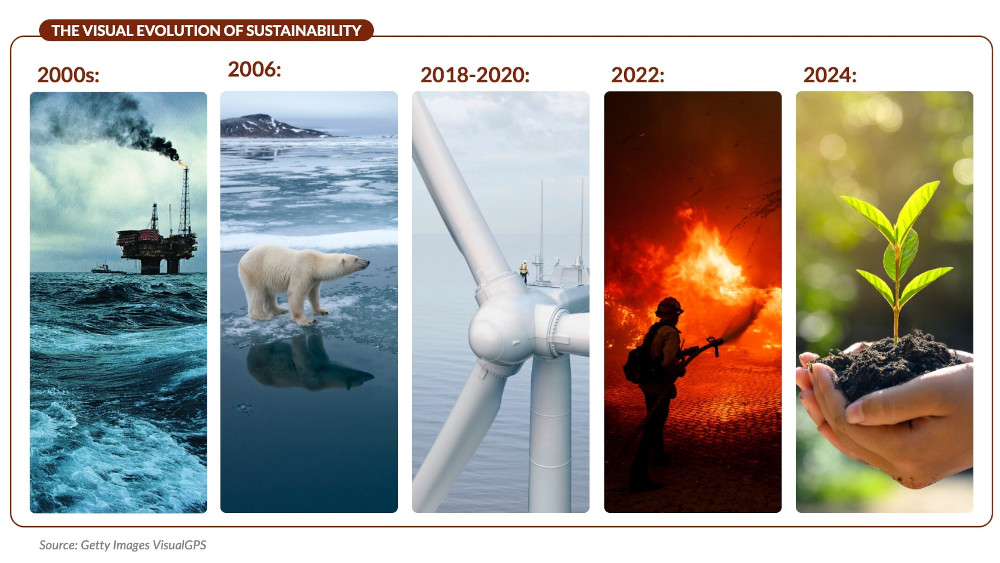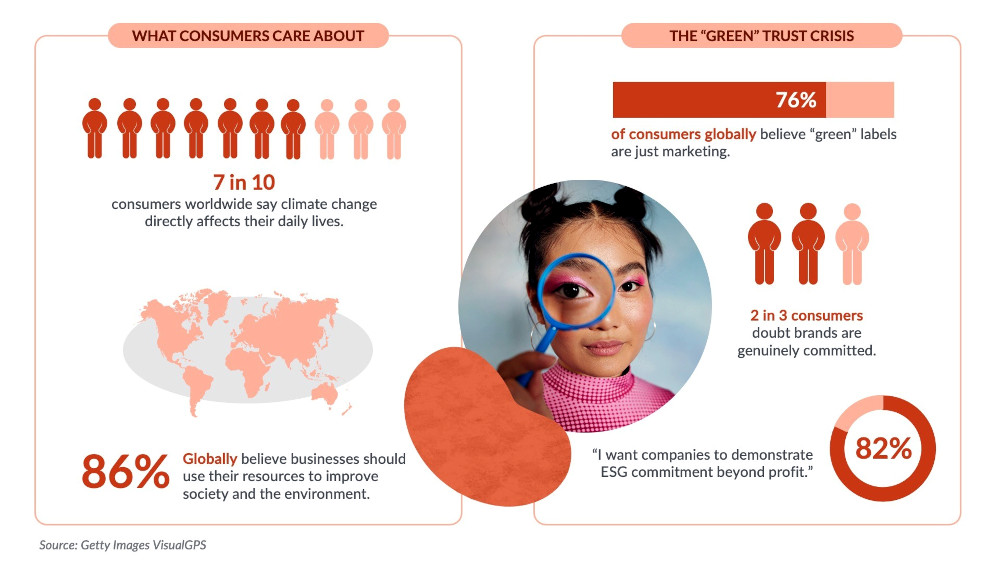Today, Getty Images released the latest report
from its VisualGPS global insights
platform, Sustainability at the
Crossroads.
The study explores current consumer sentiment around sustainability and offers
actionable insights and data-driven guidance to help brands communicate CSR
commitments with authenticity, clarity and impact in a rapidly evolving media
landscape.
With the report finding 69 percent of consumers worldwide recognize the
direct impact climate change currently has on their daily lives, the issue
is becoming an increasingly personal reality. Amid this growing awareness and as
climate-related issues continue to permeate public
discourse,
some brands and organizations are treading carefully regarding how they
communicate their climate-action efforts — or if they do so at all — otherwise
known as
greenhushing.
Visual analysis in the report traces the evolution from symbolic imagery such as
polar bears in 2006 to stark, real-world depictions of climate impacts including
floods, fires and
displacement
from roughly 2018-2022. More recently, brand reticence has shifted the trend
from clarity to conceptual representation, with brands adopting abstract visuals
with natural elements to signal ‘eco-friendliness’ without making direct claims.
However, research suggests that staying silent may carry its own risks: Nearly
9 in 10 consumers worldwide believe business should use their resources to
improve society and the environment, and 82 percent agree that companies
should have sustainability guidelines and practices in place to show they care
about more than just profit — sentiments echoed both in recent consumer
studies and in Brand Finance’s latest
Sustainability Perceptions
Index.
 Image credit: Artur Debat/Getty Images
Image credit: Artur Debat/Getty Images
At the same time, skepticism is rising: 76 percent of consumers worldwide
question the credibility of brands’ environmental claims, and 2 out of 3
globally doubt that companies are genuinely committed to sustainability.
As pressure builds around accountability, the report underscores the need for
brands to communicate with clarity — backing up ESG strategies with visual
storytelling that is authentic and aligned with real-world impact.
 Image credit: Artur Debat/Getty Images
Image credit: Artur Debat/Getty Images
“What years of studying sustainability imagery has shown me is that the
commercial focus on sustainability surges in times of cultural urgency and
recedes in moments of economic pressure or shifting priorities,” said Dr.
Rebecca Swift, SVP of Creative at
Getty Images. “We are now in that period of pull-back, but this new VisualGPS
research tells us that consumer expectations are louder and more urgent than
ever. People want to see real action, and they want to believe in the impact
they are seeing. Visual storytelling is a key vehicle for answering this call.”
Honesty is the new visual standard
Data for Sustainability at the Crossroads was gathered through global
VisualGPS consumer surveys conducted between July 2022 and July 2024. The
research included adults aged 18+ from 25 countries — including Australia,
Brazil, France, Germany, Italy, Japan, Singapore,
Spain, the UK and US — with survey sample sizes ranging from 5,300
to 7,000 respondents.
Overall, consumers appreciate transparency that goes beyond a polished narrative
— where showcasing challenges alongside progress creates a more authentic and
complete picture. But businesses operate within the context of economic
conditions, political shifts and regulatory changes — all of which can increase
climate anxiety and challenge sustainability efforts. Striking the right balance
between ambition and practicality remains critical for engaging audiences.
Given its reach, the report highlights key differences in consumer perception of
sustainability visuals across various markets:
-
Europe: Unvarnished truth — European consumers increasingly demand that
align both their actions and their messaging with environmental
responsibility. 75 percent say they want to see ‘images or videos detailing
how companies and/or governments are addressing climate change/environmental
issues.’
-
Honesty in Asia-Pacific — Transparency around environmental claims is
increasing across Asia-Pacific, driven by stricter regulations on
greenwashing. In fact, in Southeast Asia — where a large majority say they
are directly seeing the impact of the climate crisis in their day-to-day
lives — this figure rises to 88 percent.
-
A visual disconnect in The Americas — When it comes to honesty, it’s
important to strike the right visual balance in the United States.
Extreme emotional ranges (e.g., humor vs overly pessimistic imagery) are
less likely to be well-received. Americans are more likely to prefer
optimistic messaging, as long as it still tells an honest story. Popular
visuals used by brands in the US are twice as likely to feature picturesque
natural landscapes rather than those highlighting the effects of climate
change. However, 56 percent
agree
that if sufficient action hasn’t been taken to help reverse climate change,
messaging on the topic should focus on the decline and devastation that will
occur if actions aren’t taken. Conversely, Latin American consumers
prefer more frank messaging that showcases what happens when we fail to
implement sustainable practices. However, popular visuals in Latin America
primarily focus on the untouched beauty of the natural world and emphasize
themes of collaboration and protection.
-
The need for nuance — Regardless of geography, brands can better reflect
the realities of all communities by highlighting diverse demographics and
their unique challenges and aspirations. This approach fosters a
comprehensive dialogue around sustainability that includes everyone’s voices
and experiences, ultimately driving sustainable development for all.
5 ways to visualize sustainability for today’s consumer
As climate risk becomes inextricably linked to business
risk,
the report offers brand leaders, marketers and communicators five principles for
aligning their visual narratives with their strategic sustainability goals:
-
Authenticity over perfection: 81 percent of consumers want to see
visuals that show how the environment is being affected by climate change, favoring transparent and realistic imagery that shows
both progress and challenges over idealized or symbolic depictions.
-
Balance eco-anxiety with eco-optimism: 78 percent want to see how things
are improving — whether through individual, corporate or policy-driven
action. Powerful storytelling should blend impactful imagery with tangible
actions,
showing both environmental challenges and proactive solutions.
-
Highlight the potential, and drawbacks, of new technologies: 83 percent
of consumers believe AI could
positively impact the climate crisis within the next five years.
However, concerns about AI’s carbon
footprint
are real. Only 41 percent see AI as having a positive impact on energy
efficiency. As generative
AI use
continues to grow, its environmental impact should be considered when
visualizing technology. Brands can leverage visuals that have a deep focus
on the benefits and real-world impact of all technological
innovations to
inspire
trust
and drive engagement.
-
Make sustainability accessible: 81 percent want to see images and videos
that reflect how people have been personally affected — especially those in
the communities most impacted. Inspire action with relatable visuals that
highlight simple, everyday habits — reinforcing that conscious, sustainable
choices
can seamlessly fit into daily life for all.
-
Show integration, not isolation: 75 percent of consumers want to see
visuals showing how companies and governments are addressing climate change,
not just in isolated campaigns. Show sustainability as a core brand value.
Companies that seamlessly embed sustainability into their
identity
through product design, messaging and customer experience — when backed by
honest, unambiguous visuals — will foster deeper emotional connections and
lasting trust with consumers.
Get the latest insights, trends, and innovations to help position yourself at the forefront of sustainable business leadership—delivered straight to your inbox.
Sustainable Brands Staff
Published Jun 12, 2025 8am EDT / 5am PDT / 1pm BST / 2pm CEST